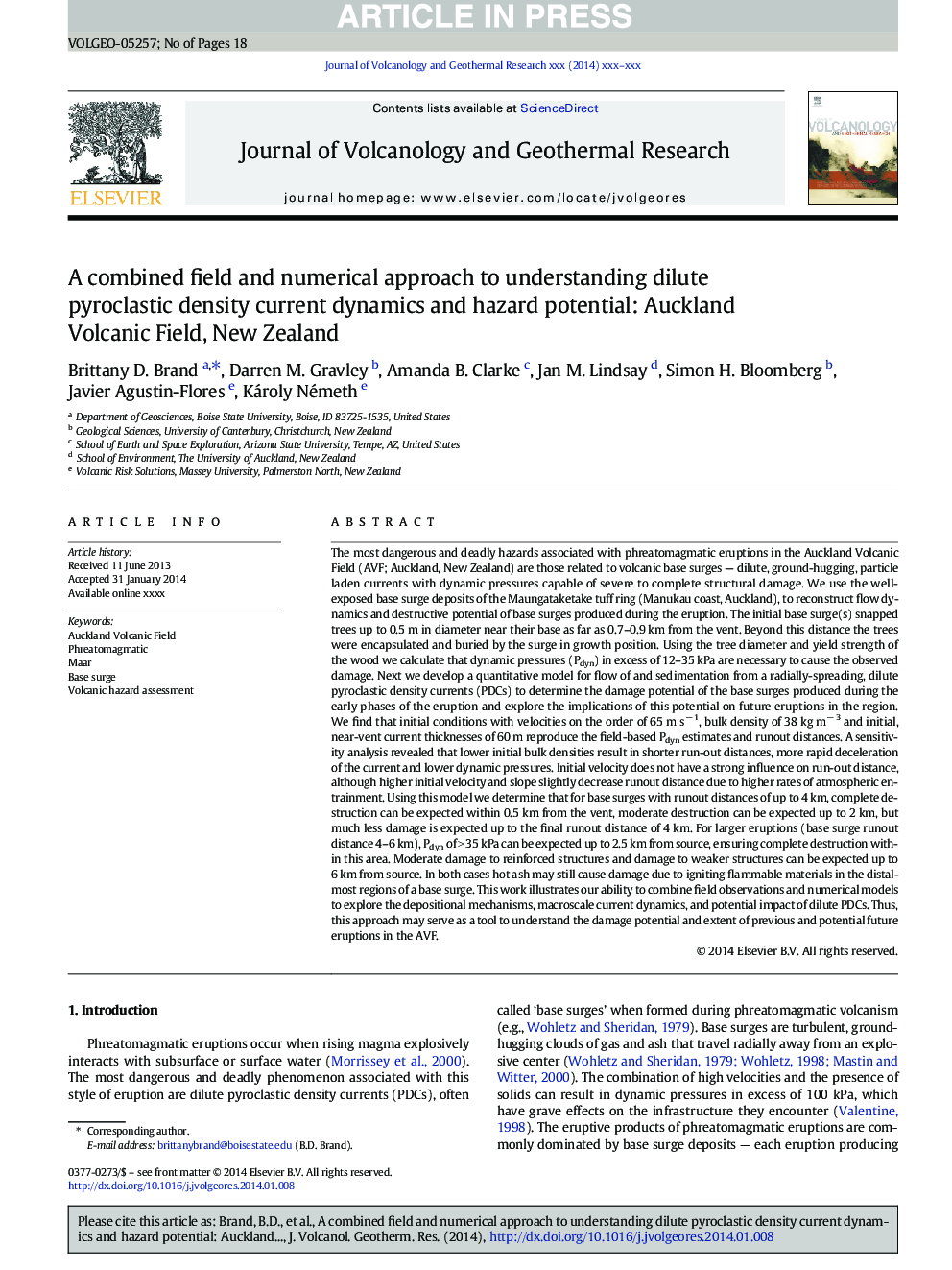| کد مقاله | کد نشریه | سال انتشار | مقاله انگلیسی | نسخه تمام متن |
|---|---|---|---|---|
| 6440077 | 1638345 | 2014 | 18 صفحه PDF | دانلود رایگان |
عنوان انگلیسی مقاله ISI
A combined field and numerical approach to understanding dilute pyroclastic density current dynamics and hazard potential: Auckland Volcanic Field, New Zealand
ترجمه فارسی عنوان
یک میدان ترکیبی و یک رویکرد عددی برای درک دینامیک جریان تراکم پری کلاستاتی و پتانسیل خطر: واگن آتشفشانی اوکلند، نیوزیلند
دانلود مقاله + سفارش ترجمه
دانلود مقاله ISI انگلیسی
رایگان برای ایرانیان
کلمات کلیدی
میدان آتشفشان اوکلند، فریاد زدن مارت، افزایش پایه، ارزیابی خطر آتشفشانها،
موضوعات مرتبط
مهندسی و علوم پایه
علوم زمین و سیارات
ژئوشیمی و پترولوژی
چکیده انگلیسی
The most dangerous and deadly hazards associated with phreatomagmatic eruptions in the Auckland Volcanic Field (AVF; Auckland, New Zealand) are those related to volcanic base surges - dilute, ground-hugging, particle laden currents with dynamic pressures capable of severe to complete structural damage. We use the well-exposed base surge deposits of the Maungataketake tuff ring (Manukau coast, Auckland), to reconstruct flow dynamics and destructive potential of base surges produced during the eruption. The initial base surge(s) snapped trees up to 0.5 m in diameter near their base as far as 0.7-0.9 km from the vent. Beyond this distance the trees were encapsulated and buried by the surge in growth position. Using the tree diameter and yield strength of the wood we calculate that dynamic pressures (Pdyn) in excess of 12-35 kPa are necessary to cause the observed damage. Next we develop a quantitative model for flow of and sedimentation from a radially-spreading, dilute pyroclastic density currents (PDCs) to determine the damage potential of the base surges produced during the early phases of the eruption and explore the implications of this potential on future eruptions in the region. We find that initial conditions with velocities on the order of 65 m sâ 1, bulk density of 38 kg mâ 3 and initial, near-vent current thicknesses of 60 m reproduce the field-based Pdyn estimates and runout distances. A sensitivity analysis revealed that lower initial bulk densities result in shorter run-out distances, more rapid deceleration of the current and lower dynamic pressures. Initial velocity does not have a strong influence on run-out distance, although higher initial velocity and slope slightly decrease runout distance due to higher rates of atmospheric entrainment. Using this model we determine that for base surges with runout distances of up to 4 km, complete destruction can be expected within 0.5 km from the vent, moderate destruction can be expected up to 2 km, but much less damage is expected up to the final runout distance of 4 km. For larger eruptions (base surge runout distance 4-6 km), Pdyn of > 35 kPa can be expected up to 2.5 km from source, ensuring complete destruction within this area. Moderate damage to reinforced structures and damage to weaker structures can be expected up to 6 km from source. In both cases hot ash may still cause damage due to igniting flammable materials in the distal-most regions of a base surge. This work illustrates our ability to combine field observations and numerical models to explore the depositional mechanisms, macroscale current dynamics, and potential impact of dilute PDCs. Thus, this approach may serve as a tool to understand the damage potential and extent of previous and potential future eruptions in the AVF.
ناشر
Database: Elsevier - ScienceDirect (ساینس دایرکت)
Journal: Journal of Volcanology and Geothermal Research - Volume 276, 15 April 2014, Pages 215-232
Journal: Journal of Volcanology and Geothermal Research - Volume 276, 15 April 2014, Pages 215-232
نویسندگان
Brittany D. Brand, Darren M. Gravley, Amanda B. Clarke, Jan M. Lindsay, Simon H. Bloomberg, Javier Agustin-Flores, Károly Németh,
